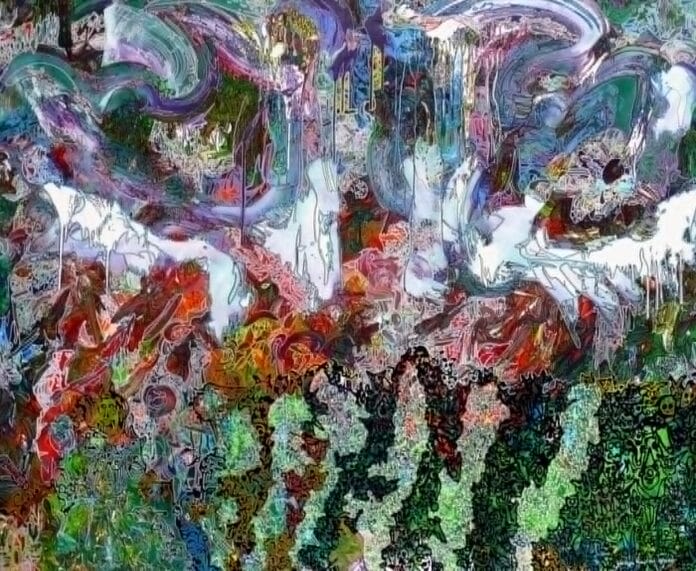Igor Eugen Prokop, born in Budapest in 1953, stands at the intersection of science, philosophy, and art. Living and working in Visegrád, Hungary, Prokop has spent decades cultivating a deep, multidisciplinary understanding of the world. His studies in biology, philosophy, art, film aesthetics, design management, and environmental protection have shaped a practice that transcends conventional artistic boundaries. For Prokop, art is not merely a form of expression; it is an inquiry into the mechanisms of life and the moral questions surrounding humanity’s role within the natural order.
Prokop’s artistic vision reflects a rare synthesis of scientific precision and creative freedom. Each of his works bridges the analytical rigor of a scientist with the imagination of a visionary painter. He invites viewers to see the natural world not as a static backdrop but as a living, breathing system where every form, from the smallest cell to the vast cosmos, is interconnected.
A Vision Rooted in Nature
Nature lies at the heart of Igor Eugen Prokop’s artistic universe. His works are not simple depictions of the environment; they are philosophical reflections on existence, transformation, and responsibility. Having studied environmental protection, Prokop understands the fragile balance sustaining life on Earth. His paintings often reveal the tension between growth and decay, beauty and peril, reminding us that human progress comes at a cost if divorced from ecological awareness.
Through vibrant compositions and layered textures, he translates the invisible patterns of nature into visual poetry. Organic forms flow across his canvases in rhythmic motion, evoking microscopic life, ecosystems, and cosmic order all at once. This dynamic interplay between chaos and structure reflects both the creative power and the vulnerability of nature, a central theme throughout his career.
Artistic Philosophy: Beyond the Visible
Prokop’s art embodies the principle that true understanding begins where observation ends. His paintings challenge viewers to go beyond the surface, to look into the deeper symmetries and hidden relationships that bind all living things. By merging the languages of art and science, he constructs a dialogue about evolution, spirituality, and sustainability.
His philosophy echoes an ancient wisdom that humanity is both a product and a steward of nature. The visual complexity in his works mirrors the moral and existential complexity of the modern world, where technology and nature, creation and destruction, coexist in fragile balance. Through this lens, his art becomes a meditation on human destiny, a reminder that our choices shape not only our world but the very fabric of life itself.
Global Recognition and Exhibitions
Over the years, Igor Eugen Prokop’s art has reached an international audience, earning him a place among Europe’s most thought-provoking contemporary artists. His works have been displayed in prestigious institutions and exhibitions worldwide, including the Grand Palais in Paris, NordArt in Germany, and the Florence Biennale.
At each venue, Prokop’s paintings have drawn attention for their intellectual depth and visual vitality. Critics often praise his ability to merge disciplines, creating a dialogue between art and science that resonates across cultures. His exhibitions serve as both aesthetic experiences and educational journeys, urging audiences to reflect on the interconnectedness of all life forms.
“1001 Players in the Evolution of Life”
One of Prokop’s most compelling works, “1001 Players in the Evolution of Life,” encapsulates his multifaceted approach. The painting offers a subtly satirical vision of human evolution, portraying nature as a stage where countless forces, gods, devils, and angels interact in an intricate dance of creation and destruction.
In this work, mythology and science converge, illustrating humanity’s eternal struggle to reconcile knowledge with belief, progress with morality. The vibrant imagery blurs the line between the earthly and the divine, emphasizing that evolution is not merely biological but spiritual and cultural as well.
Prokop’s brushstrokes seem to animate the canvas, giving life to a swirling ecosystem of figures and forms. The result is a visual symphony, a narrative of transformation that captures both the grandeur and fragility of existence. Each element, from the smallest creature to celestial symbols, represents a “player” in the ongoing evolution of life, reminding us that every being holds significance in the grand design of nature.
A Legacy of Awareness and Connection
Through his lifelong exploration of nature, science, and art, Igor Eugen Prokop continues to inspire reflection on humanity’s place within the greater universe. His works are not only visually striking but deeply ethical, inviting a reexamination of our relationship with the environment and with one another.
In a time marked by ecological uncertainty, Prokop’s paintings stand as both warnings and celebrations. They urge us to preserve what remains of the natural world while marveling at its boundless creativity. His art captures the pulse of life, its rhythms, transformations, and enduring resilience and offers a vision where science and spirituality, reason and imagination, coexist in harmony.
Conclusion
Igor Eugen Prokop’s oeuvre represents more than artistic mastery; it is a lifelong dialogue between knowledge and wonder. Rooted in scientific understanding yet elevated by spiritual insight, his art reminds us that humanity’s greatest task is not to dominate nature but to understand and protect it.
In works like “1001 Players in the Evolution of Life,” Prokop invites us to witness the unfolding story of existence, a story in which every living thing, seen or unseen, plays an essential role. Through his fusion of art and science, he leaves behind a timeless message: that life itself is the ultimate masterpiece, and we are both its creators and its caretakers.


